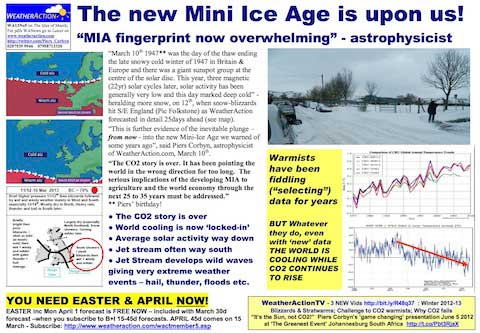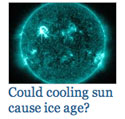
It might be about the last ice age, but global warming concerns are never far away in Brian Fagan’s latest book The Complete Ice Age: How Climate Change Shaped the World. Fagan collaborates with three other writers to explain how our understanding of the ice age has developed since the great 19th century achievement of its discovery. A book for the general reader, its content is well explained in medium-length chapters with many photographs and helpful illustrations.
Fagan kicks off with an account of how geologists first began to interpret the signs of glaciation and to posit the advance of great continental ice sheets in northern land masses. He also describes the early searches for clues as to when and why the ice age had begun and how many glacial events it may have included, culminating in the essential validity of theories that variations in the motion of the earth around the sun triggered the multiple glaciations.
Paleoclimatologist Mark Maslin takes up the story, first looking at the possible confluence of events, particularly tectonic, which pushed the warm planet of 50 million years ago into increasing coldness. A near ice age 5 million years ago seems to have been aborted by the influence of ocean currents, but full onset was realised some 2.5 million years ago. A climatic rollercoaster followed, with many glacial-interglacial cycles, alternating coldness and warmth. The waxing and waning of the huge continental ice sheets was initiated by changes in the earth’s orbit around the sun which were then amplified and transformed by various feedback mechanisms. Sometimes things happened quickly. The so-called Heinrich events, massive collapses of the North American Laurentide ice sheet, which added enormous quantities of cold fresh water to the North Atlantic and altered ocean currents provide a stark warning of the possible extreme and rapid effects of climate change in the future.
John Hoffecker, an expert on human adaptations to cold climates, offers a fascinating chapter on the human response to the ice age. Novel forms of humankind evolved repeatedly in Africa and migrated into Eurasia during the Ice Age, confronting either intense cold or intervals of warmth. Homo sapiens, finally, with the emergence of mind brought a new capacity for adaptation to environmental challenges. They spread into an astonishing range of habitats and climate zones without differentiating into new species, and displaced their cold-adapted Neanderthal cousins. One hopes that the creative powers of mind will be adequate to the rather different range of challenges ahead.
Paleontologist Hannah O’Regan completes the picture with a survey of the animal life of the ice age. Megafauna survived all glacials but the last, and while acknowledging the controversy surrounding the extinctions O’Regan notes that what differentiates the last glaciation from the others is the arrival of modern humans on all continents.
Fagan returns with a chapter on the way human communities have adapted and flourished in the ten or so millenia since the last glacial period. Sea level rises in the order of 90-120 metres were among the staggering environmental changes initially faced. The relatively stable climatic conditions of the Holocene have seen the development of agriculture and animal domestication and the appearance of civilisation, but even minor temperature and rainfall shifts within this context have had dramatic effects on human societies, especially through the incidence of famine. “We would be rash to assume that our own cities are impregnable to climatic forces that are beyond our control.” (Readers of Brian Fagan’s absorbing earlier book on the medieval warm period The Great Warming will recall his reconstruction of the devastating effects of drought on many civilisations of the time and his expressed concern that future global warming, unprecedented for human society, will include drought that will severely affect crowded populations in vulnerable parts of today’s world.)
As Mark Maslin reminds us in a final chapter on the future, we are part of the ice age and depend on its legacy. The huge ice sheets of Greenland and Antarctica are witness to that. What happens if you put lots of greenhouse gases into the atmosphere of a planet with lots of ice sheets? That is the experiment which is now under way. What the study of the Ice Age tells us is that when climate changes it can do so suddenly and without warning. The book adds its voice to the many warning us that the experiment is dangerous and should be stopped.
The study of past climates is important for our understanding of the present and the future we are storing up, as a number of books reviewed on Hot Topic make clear, including Broecker’s Fixing Climate, Ward’s Under a Green Sky, Turney’s Ice, Mud and Blood and Archer’s The Long Thaw. But in a book like this one by Fagan and his associates there’s also an intrinsic interest in the picture of the past that is being constructed as the jigsaw is assembled. I read it partly for the sheer pleasure of sensing the past, untroubled, albeit only briefly, by anxieties about the future.
Like this:
Like Loading...
 Forget all that nonsense about “no warming for 16 years”, to be a real sceptic these days you have to insist that the climate’s currently cooling. But why stop there? To show your real commitment to the coolist cause, you have to go BM (Beyond Monckton) and insist that the next ice age is descending on us. And that’s exactly what Britain’s nuttiest weather forecaster, Piers Corbyn, is proclaiming. Britain’s had a bit of snow and a cold start to March, so Piers jumps on his soapbox and cries “The new Mini Ice Age is upon us!”
Forget all that nonsense about “no warming for 16 years”, to be a real sceptic these days you have to insist that the climate’s currently cooling. But why stop there? To show your real commitment to the coolist cause, you have to go BM (Beyond Monckton) and insist that the next ice age is descending on us. And that’s exactly what Britain’s nuttiest weather forecaster, Piers Corbyn, is proclaiming. Britain’s had a bit of snow and a cold start to March, so Piers jumps on his soapbox and cries “The new Mini Ice Age is upon us!” 

 Fairfax New Zealand’s news web site
Fairfax New Zealand’s news web site